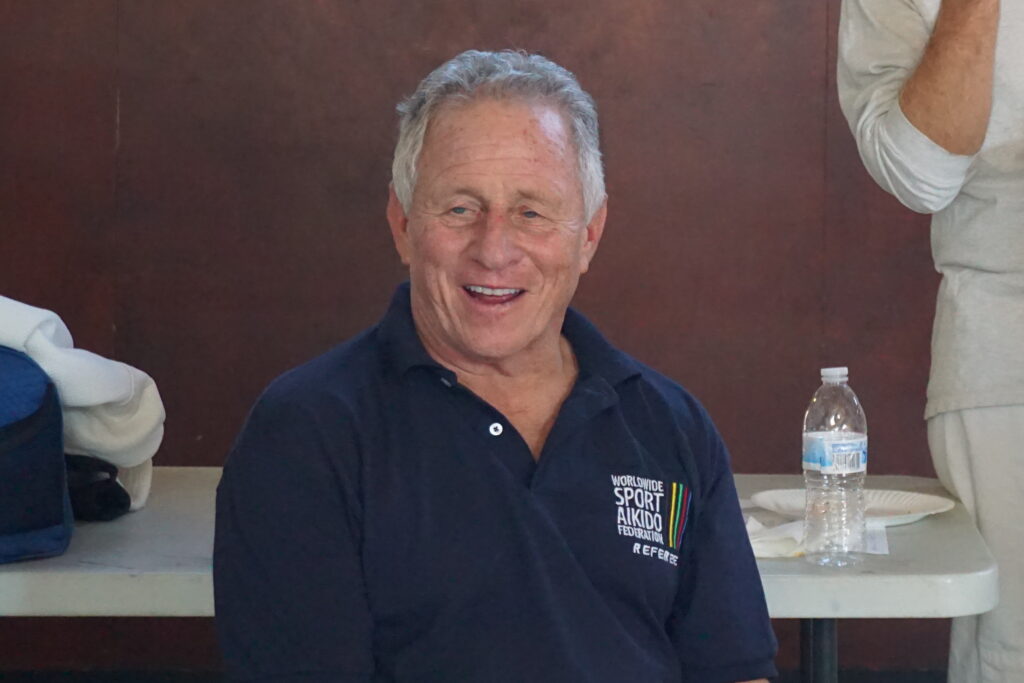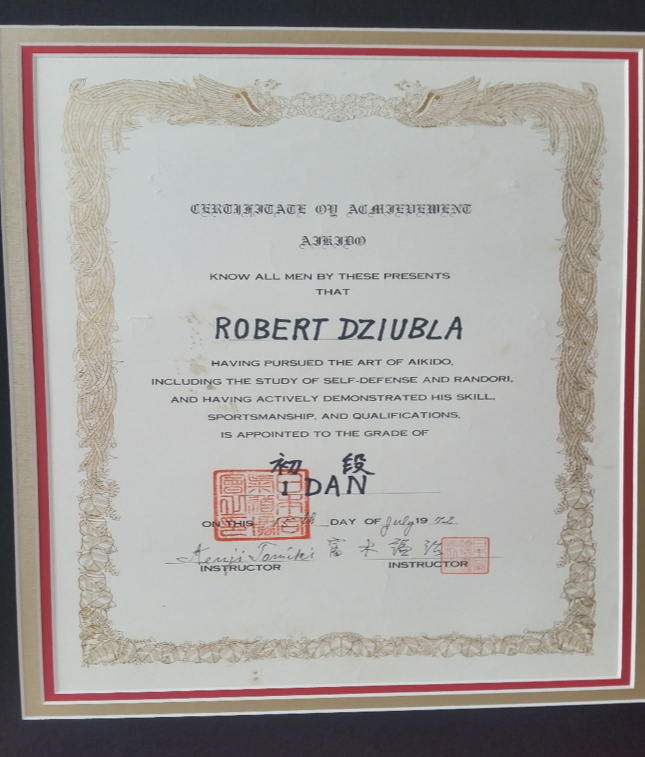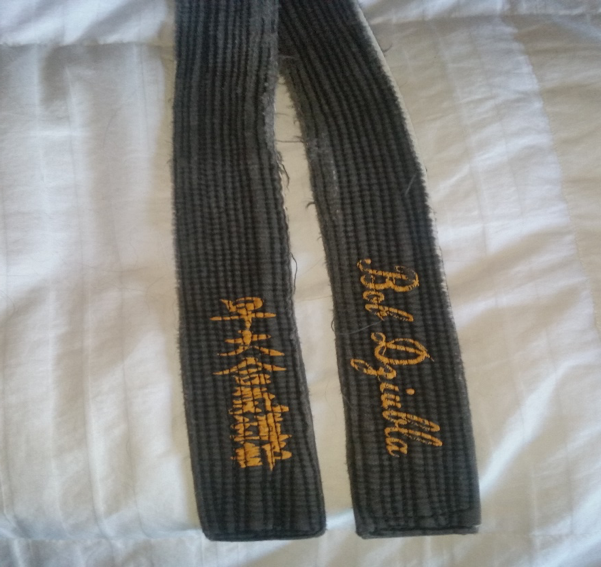Tomiki News (TN): Tell us about yourself. Where is your family from? What interests do you have outside of aikido?
Dziubla Shihan (RD): I was born and raised in Chicago in a blue-collar family. My father owned a live poultry store where I started working when I was 8 – that continued until I was 17 when he sold the poultry store and bought an outdoor newspaper stand in downtown Chicago. I worked there until I went to Japan to study aikido for the second time in 1975 when I was 23. Both jobs were demanding and tough and inspired me (along with my Dad’s poignant advice) to pursue my education. Working at the newspaper stand, outside on the streets of downtown Chicago from 6 a.m. to 7 p.m., summer and winter, left me no choice but to use my aikido (and karate) skills when street thugs tried to rob us, though I had first started studying aikido when I was 13 because a couple of older teen-age boys beat me up pretty badly.
I received my B.A. in East Asian Studies from Northwestern University in 1974, my M.A. in Political Science (China focus) from the University of Chicago in 1978, my J.D. (law degree) from Northwestern University School of Law in 1980, and my LL.M. (Masters of Law) in Asian Law from the University of Washington Law School a few years later. After practicing law in Chicago for a couple of years and getting my LLM, I was awarded a Senior Fulbright Fellowship at the University of Kyoto, Faculty of Law, in the early 1980s, where I researched and wrote on Japanese corporate and securities law – it was during this period that I traveled from Kyoto to Osaka several times per week to study aikido at Shodokan under Nariyama Sensei.
Though aikido is my lifelong passion at this point, outside of that I have a deep and abiding interest in flying (I received my pilot’s license when I was 17) and currently hold a multi-engine instrument rating. When I lived in Los Angeles, the LA County Supervisors appointed me to be a member of the Los Angeles Aviation Commission, which oversaw all flight operations in Los Angeles County.
I also greatly enjoy skiing and scuba diving, though both are now on a back burner given my multiple neck and back surgeries.
Teaching is another deep interest of mine. In addition to teaching aikido at University of California – San Diego (UCSD) and Mesa College, I have taught courses on International Finance Law and on International Business Transactions at both the USC Law School and the University of San Diego Law School.
TN: What is your current rank, and what associations or organizations are you a part of?

RD: I am an 8th dan and serve as the Chairman & President of the TAA. I also serve as the Deputy President of the Worldwide Sport Aikido Federation (WSAF) and as Chairman of the Board.
TN: Who would you consider the teacher who has had the most influence on you? What was it about his/her teaching that impacted you so much?
BD: That’s easy, Tomiki Sensei!
Though I started studying aikido in Chicago in 1963 or so, my sensei there was not very good. I didn’t find that out, however, for many years because I was a wet-behind-the-ears teenager. In fact, it turned out that he had never really studied aikido; he had studied some judo, got bored with it, and then bought some books on aikido which he tried to use to teach himself. What he taught me was pretty useless stuff that I had to unlearn later. The bright side is that he lacked the rank to promote me to black belt, so he insisted that I go to Japan to get my black belt from Tomiki Sensei himself.
Tomiki Sensei was my first true Aikido Sensei, and he was amazing. He was a professor at Waseda University, one of the most elite universities in Japan where it is referred to as one of the “Four Jewels” of higher education in Japan (along with Tokyo U., Kyoto U. and Keio U.). Tomiki Sensei was a very smart and talented man, but also very humble. At the end of my first stay at Waseda in 1971, he took me out to dinner at the Waseda University Faculty Club, where he gave me my very first black belt with my name inscribed on one end and “Waseda University Aikido Club” in Japanese kanji on the other end. I still have that black belt, though it is well worn by now as you can see. (Smile)

As he gave it to me he said, “When you go back to America, please teach and spread Tomiki Aikido as much as you can because we Japanese are not very good dealing with foreigners.” I was deeply touched by that adjuration, and I still try to fulfill it! It took a year for me to receive my certificate because Tomiki Sensei had not, he explained, previously awarded any black belt certificate in English, so it took him a while to develop the wording and format. We use that to this very day as the model for our TAA black belt certificates.
During that first visit, Shishida Sensei was one of my teammates on the Waseda Aikido Club, and we remain very close friends to this day. He, too, has had a strong influence on my aikido, and he was instrumental in guiding me in my readings in Japanese of Tomiki Sensei’s many writings.
Thanks to Shishida Sensei’s recommendation and introduction, I ended up spending about two years training at Shodokan under Nariyama Sensei. That’s an interesting story.
At the end of my second period training at Waseda in the mid-1970s, my teammates took me out for my sobetsu-kai, a farewell party. After many, many rounds of beer and sake, they confided to me that “Bob-san, you are a henna gaijin [strange foreigner] and we’re impressed with your desire to train and master Tomiki Aikido. But most Americans are dumb, fat and lazy, so we’re not too worried about America every fielding an aikido team that can compete with us.” That irked me, and I responded “Just wait and see. I’m going back to America, and I’ll put together a team that can give you a run for your money.” They laughed.
I returned to Northwestern University Law School in Chicago and, over the next many years, built a dedicated team that I took to Japan in 1982. We had arranged to have a tournament with Waseda, as Shishida Sensei was the coach of the Waseda Aikido Club at the time. Well, we had a 13-person team match (or at least I think it was 13, it might have been fewer), including Greg Linden, who still plays aikido and is one of our TAA Board members. At the end of all the matches, it was a tie. Stan Nevin, who was the deputy captain of our team, and I did rock-scissors-paper to see who would fight the tie-breaking match. I lost, so I had to do it. Fortunately, I was able to eke out a win, to the delight of my teammates and the chagrin of Shishida Sensei and the Waseda team. After that tournament, Shishida Sensei told me that I needed to take the entire team down to Osaka to train at Shodokan with Nariyama Sensei. I didn’t know Nariyama Sensei at that time, though I had seen him in passing once or twice during my prior stays in Japan.

So, we went to train at Shodokan. I was awestruck by the power, precision and beauty of Nariyama Sensei’s aikido techniques, and I vowed that I would find a way to train at Shodokan for an extended period until I could do the same.
In 1983 or so, I was awarded a Senior Fulbright Fellowship to study Japanese corporate and securities law at Kyoto University, Faculty of Law. I was delighted that it had worked out that way because Kyoto is a beautiful city, Kyoto University is a wonderful place and, best of all, Kyoto was only an hour and a half away from Osaka…so that I could commute to Shodokan several times per week and train under Nariyama Sensei, which I did for a couple of years. I made many close and life-long friends there.
TN: What would you say is your most significant achievement within Tomiki Aikido? Why?
BD: Well, I have been doing aikido for 53 years now, so there are several accomplishments that would, I think, make my first real sensei, Tomiki Sensei, happy. First, in 1990, with the help and cooperation of many folks around the US, we were able to create the TAA (our original name was Japan Aikido Association (USA), but we changed that to Tomiki Aikido of the Americas many years ago to better reflect our history and approach). Second, I won a gold medal at the 1993 World Championship in Japan – I was the first foreigner ever to do that – and it opened up the door to making Tomiki Aikido a more international martial art / sport. And most recently, with the help and support of the TAA Board, I was able to spearhead the founding of the Worldwide Sport Aikido Federation (WSAF), which just hosted the largest and most successful world championships in London in August 2017. Our friends at the BAA did a phenomenal job of organizing and running that tournament!
Though it likely won’t happen in my lifetime, I hope that the TAA and the BAA will help lead the WSAF so that we are successful in getting Tomiki Aikido recognized as an Olympic sport with the WSAF as the true worldwide governing body for that.
TN: How long have you been studying aikido? Have you studied other budo?
BD: 53 years. Yes, I have studied many other martial arts: karate, judo, kendo, iaido, tai chi, tai chi chuan.
TN: If you have studied other budo, what styles?
BD: I studied Shotokan Karate for a few years, with a smattering of Taekwondo. The other martials arts did not have particular styles that I knew of at the time.
TN: What is an area of aikido (or other budo) which is of great interest to you?
BD: I remain intrigued by the meditative aspects of aikido and all martial arts. A fundamental precept in most martial arts is having a calm heart and mind (i.e., ju no ri, the principle of gentleness; also, mushin mugamae, “No Emotion, No Stance”) so that your emotions do not impede your body, so that there is instantaneous response between your consciousness and your body. If you let your emotions rule you, then you are trying to force your techniques upon your opponent. And that will slow you down and detract from the power, precision and, indeed, even beauty of the techniques. As I constantly tell my students, “Uke’s body is ALWAYS telling you where it wants to be thrown and how. Your job is to listen and understand.”
I often re-read the book Zen and Aikido by Shigeo Kamata and Kenji Shimizu to stimulate my thinking on this.
One item on my final to-do list is to translate into English, Tomiki Sensei’s lengthy book entitled Tai-iku to Budo, which translates as “Physical Education and Budo”, as it does a great job of explaining his views on this important topic.
Comments are closed